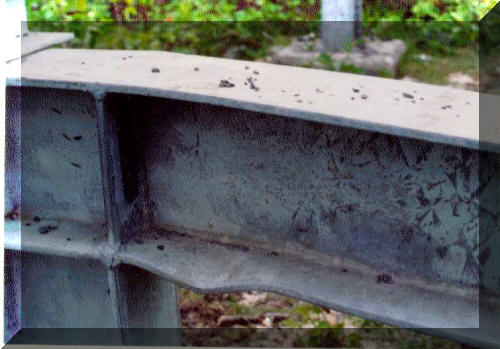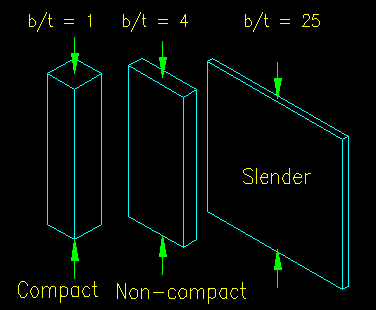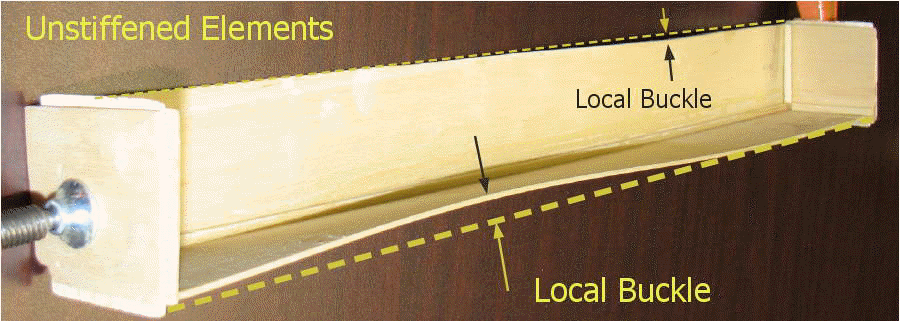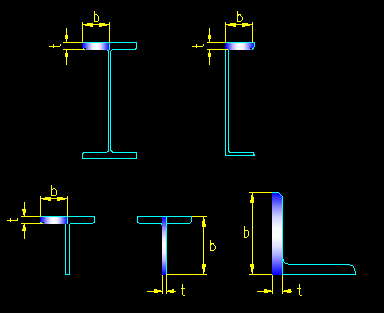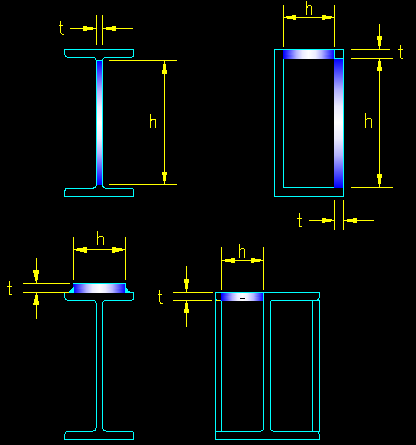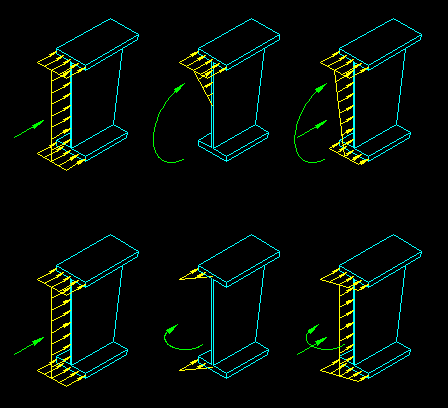|
|
Section 6.3
Local Buckling
Last Revised: 11/04/2014
|
Figure 6.3.1 |
The cross sections of steel shapes tend to consist of an assembly of thin plates. When the cross section of a steel shape is subjected to large compressive stresses, the thin plates that make up the cross section may buckle before the full strength of the member is attained if the thin plates are too slender. When a cross sectional element fails in buckling, then the member capacity is reached. Consequently, local buckling becomes a limit state for the strength of steel shapes subjected to compressive stress.
Figure 6.3.1 shows an example of flange local buckling. This member failed before the full strength of the member was realized because the slender flange plate buckled first.
In the Euler equation the parameter (L/r) is known as the slenderness of the member. For a plate, the slenderness parameter is a function of the width/thickness (b/t) ratio of a slender plate cross sectional element. In the SCM member cross sections are classified, as introduced in the prior section, as being COMPACT, NON-COMPACT, or SLENDER based on the width/thickness ratios of the plate elements that make up their cross sections. All cross sections can be classified solely on cross sectional dimensions and type of steel being used.
|
Figure 6.3.2 |
Members with plates having b/t ratios between 0 and lp are said to be "compact" and can be expected to not exhibit any buckling behavior. Their compressive strength is limit by the material compressive strength as seen in Figure 6.1.3.
Members with plates having b/t ratios between lp and lr are said to be "non-compact" and exhibit both plastic and elastic buckling behavior. Their compressive strength is limited by inelastic buckling.
Members with plates having b/t ratios greater than lr are said to be "slender" and exhibit elastic buckling behavior. Their compressive strength is limit by elastic buckling.
Figure 6.3.2 gives a general depiction of the difference between compact, non-compact and slender elements. In the figure, all three plate elements have the same length and the same cross sectional area, however the width/thickness ratios are different.
Stiffened vs. Unstiffened Elements
The SCM defines two different types of plate elements in a cross section: Stiffened and Unstiffened. See SCM B4.1 and B4.2 for the definitions. If a plate's edges are restrained against buckling, then the force required to buckle the plate increases. If one edge is restrained (i.e. and "unstiffened" plate element) the force to cause out-of-plane buckling is less than that required to buckle a plate with two edges restrained against out-of-plane buckling. An intersecting plate at a plate edge adds a significant moment of inertia out of plane to the edge which prevents deflection at the attached edge.
Figure 6.3.3 illustrates the modes of buckling for a stiffened and unstiffened plate elements.
Figure 6.3.3
Plate Buckling Modes
Click on image for larger view
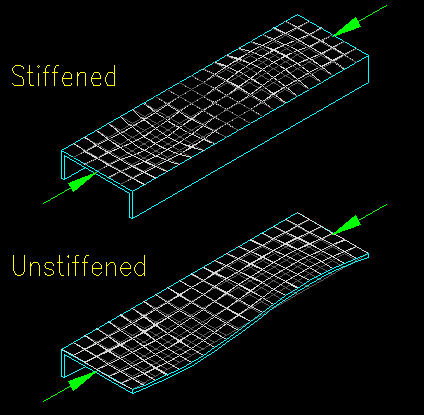
Figure 6.3.4 shows a buckled unstiffened element from an experiment. In this experiment, an "L" shaped cross section was create with thin wood plates. Each of the wood plate elements is "unstiffened" since only one edge is restrained (by the intersecting plate) against out of plane buckling. As a uniform axial compression is added to the member, the initial failure mode is local buckling of the plate elements as shown in the image. As both plates have the same b/t ratio, they both buckled at the same time. Note that the member is not slender (is short with fairly larger "r") so the buckling is not general buckling.
Figure 6.3.4
Buckled Unstiffened Element
Click on image for larger view
Figure 6.3.5 shows the unstiffened elements on some typical steel sections and the measurement of the element width, b, and thickness, t. Note that a "W" section has four unstiffened elements (i.e. each of the outstanding half flanges, all of equal size), a "WT" has three unstiffened elements, a channel has two unstiffened elements, and an angle has two unstiffened elements. When a section has multiple plate elements, the most slender element will control the definition of the member as being compact, non-compact, or slender.
Figure 6.3.5
Unstiffened Elements
Click on image for larger view
Figure 6.3.6 shows the stiffened elements on some typical steel sections and the measurement of the element width, h, and thickness, t. Note that "W" shapes and channels each have one stiffened plate element in their cross section. A square or rectangular HSS has four stiffened elements in it's cross section. Normally unstiffened plate elements can stiffened with the addition of added plate elements as seen in the figure.
Figure 6.3.6
Stiffened Elements
Click on image for larger view
Note that some members have both stiffened and unstiffened elements. The "W" sections and channels are examples of sections with both types of elements in their cross sections.
Stress Distribution
|
Figure 6.3.7 |
|
|
Another factor effecting buckling is the nature of the compressive stress that the element is subjected to. Euler's equation assumes uniform compression. If the compressive stress is not uniform then the onset of buckling is a bit more complicated and methods for determining buckling must account for the stress distribution. Typically any non-uniform stress distribution will require greater maximum compressive stress to initiate buckling than that required to initiate buckling under a uniform stress
As learned in mechanics, normal stress distribution can be characterized as being a function of an applied concentric force and a moment (or moments) about the centroidal axis. Using the basic stress equations for axial force and bending, the force distribution is planar (in 3D) or linear (in 2D). Figure 6.3.7 shows some typical stress distributions on a wide flange section. The top row illustrates combined axial and bending about the strong axis of the member. The lower row illustrates combined axial and bending about the weak axis of the member.
The SCM Section Slenderness Classification
When analyzing a steel section where there is compressive stress on some or all of the cross section, the steel section must be classified as being compact, non-compact, or slender so that the appropriate strength equation can be applied.
SCM B4 (pg 16.1-14) defines the method used for classifying a section. Where a cross section consists of multiple plate elements (both stiffened and unstiffened), the most restrictive case (i.e. the most slender definition) defines classification of the section. The actual classification system is tabulated in SCM Table B4.1 (SCM page 16.1-16). The table describes the various conditions, how to compute the width/thickness ratio and the limits lp and lr that defined the limits of the slenderness regions.
[2010 Spec note: Table B4 has been upgraded to a much more user friendly format. You might want to take a look at it.]
The first eight cases listed in SCM Table B4.1 refer to unstiffened elements. The remainder refer to stiffened elements. The table includes figures to illustrate the definitions of the various components. What the table does not include is a graphical representation of the stress distributions that apply to each case. The applicable stress state is included in the element description.
Note that the cases for unstiffened elements do not include the effects of combined compression and bending. The equations conservatively assume that uniform compression due to either flexure or compression in the elements.
For the stiffened element cases, the combination of flexure and compression is considered separately from the cases of pure compression and pure bending for I shaped members. This only affects the limit lp. The application of this case is discussed later in the text when combined axial and bending forces in a member are covered.
<<< Previous Section <<< >>> Next Section >>>
